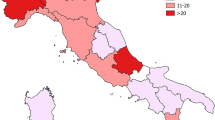Abstract
Every year floods cause enormous damage all over the world. This study investigates loss of human life statistics for different types of floods and different regions on a global scale. The OFDA/CRED Database contains data on international disasters and is maintained by the Centre for Research on the Epidemiology of Disasters in Brussels (CRED) in cooperation with United States Office for Foreign Disaster Assistance (OFDA). Information from this source on a large number of flood events, which occurred between January 1975 and June 2002, is evaluated with respect to flood location and flood type. Due to the limited availability of information on coastal flood events, the scope of this study is limited to three types of freshwater flooding: river floods, flash floods and drainage problems. First, the development of loss of life statistics over time is discussed. Second, the dataset is analysed by region, by flood type and by the combination of type and region. The study shows that flash floods result in the highest average mortality per event (the number of fatalities divided by the number of affected persons). A cross analysis by flood type and location shows that average mortality is relatively constant for the different types over various continents, while the magnitude of the impacts (numbers of killed) and affected for a certain type varies between the different continents. On a worldwide scale Asian river floods are most significant in terms of number of persons killed and affected. Finally, a comparison with figures for other types of natural disasters shows that floods are the most significant disaster type in terms of the number of persons affected.
Similar content being viewed by others
References
B. Appleton (Eds) (2002) Climate Changes the Water Rules Dialogue on Water and Climate Printfine Ltd., Liverpool, UK
G. Berz W. Kron T. Loster E. Rauch J. Schimetschek J. Schmieder A. Siebert A. Smolka A. Wirtz (2001) ArticleTitleWorld map of natural hazards–a global view of the distribution and intensity of significant exposures, Nat Hazards 23 443–465
A. Chowdhury R Mushtaque A. U. Bhuyia A. Y. Choudhury R. Sen (1993) ArticleTitleThe Bangladesh cyclone of 1991: Why so many people died Disasters 17 IssueID4 291–304
L. Coates (1999) ArticleTitleFlood fatalities in Australia 1788–1996, Aust. Geogr 30 IssueID3 391–408
J. French R Ing. S. Allmen Particlevon R. Wood (1983) ArticleTitleMortality from flash floods: A review of the national weather service reports 1969–1981, Public Health Rep 98 IssueID6 584–588
J. G. French KW Holt (1989) Floods MB Gregg (Eds) The Public Health Consequences of Disasters US Department of Health and Human Services, Public Health Service, CDC Atlanta, Georgia 69–78
Graham, W. J.: 1999, A procedure for estimating loss of life caused by dam failure, Dam safety office report DSO, 99–06.
D. Guha-Sapir R. Below (2002) The quality and accuracy of disaster data–a comparative analysis of three global data sets. Working paper prepared for the Disaster Management Facility World Bank. CRED Brussels
F. Guzzetti (2000) ArticleTitleLandslide fatalities and the evaluation of landslide risk in Italy Eng. Geol 58 89–107
S. Hajat K. L. Ebi S. Kovats B. Menne S. Edwards A. Haines (2003) ArticleTitleThe human health, consequences of flooding in Europe and the implications for public health, J Appl. Environ. Sci. Public Health, 1 IssueID1 13–21
C. E. Haque (2003) ArticleTitlePerspectives of Natural Disasters in East and South Asia and the Pacific Island States: Socio-economic Correlates and Needs Assessment, Nat Hazards 29 465–483
IFRCRCS (International Federation of Red Cross and Red Crescent Societies): 2002, World disasters report 2002.
S.N Jonkman P.H.A.J.M. Gelder Particlevan J.K. Vrijling (2003) ArticleTitleAn overview of quantitative risk measures for loss of life and economic damage J. Hazard. Mater 99 1–30
Mooney, L. E.: 1983, Applications and implications of fatality statistics to the flash flood problems, in: Proceedings of the 5th Conference on Hydrometeorology, Tulsa USA.
MMWR (Morbidity and Mortality Weekly Report): 2000, Morbidity and Mortality Associated With Hurricane Floyd -North Carolina, Sept.–Oct. 1999, MMWR 49(17), 369–372.
Münich Re Group: 2002, Topics, annual review: Natural catastrophes, www.munichre.com.
NOAA (National Oceanic and Atmospheric Administration): 2001, Service Assessment: Tropical Storm Allison, Heavy Rains and Floods, Texas and Louisiana, US Department of Commerce, National Weather Service, Silver Spring, Maryland.
C. A. Ohl S. Tapsell (2000) ArticleTitleFlooding and human health: dangers posed are not always obvious, Brit Medi. J 321 1167–1168
R. A. Pielke SuffixJr. (1999) ArticleTitleNine fallacies of floods Climatic Change 42 413–438
B. V. Shah (1983) ArticleTitleIs the environment becoming more hazardous?–A global survey 1947–1980 Disasters 7 202–209
WHO (World Health Organization–Regional office for Europe): 2002, Floods: climate change and adaptation strategies for human health.
Author information
Authors and Affiliations
Corresponding author
Rights and permissions
About this article
Cite this article
Jonkman, S.N. Global Perspectives on Loss of Human Life Caused by Floods. Nat Hazards 34, 151–175 (2005). https://doi.org/10.1007/s11069-004-8891-3
Received:
Accepted:
Issue Date:
DOI: https://doi.org/10.1007/s11069-004-8891-3




